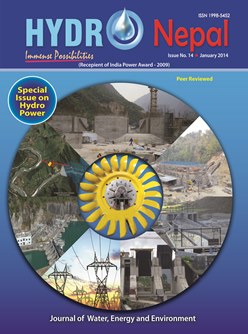The 400 kV Dhalkebar-Muzaffarpur 140 km Transmission Line Eight Years of Indo-Nepal Labor and Still No Fruit
DOI:
https://doi.org/10.3126/hn.v14i0.11273Keywords:
Cross boarder power trading, Dhalkebar–Muzaffarpur, Transmission line, Power Exchange Committee Nepal, IndiaAbstract
About eight years ago, in mid-2006, the Minister of Water Resources Gyanendra Bahadur Karki took the initiative to develop Indo-Nepal cross-border high voltage transmission lines for mutual benefit. As a result, in January 2007, Nepal Electricity Authority (NEA) and Infrastructure Leasing & Financial Services (IL&FS) signed an MOU for the construction of four 220 kV cross border transmission lines. The Butwal-Gorakhpur and Duhabi-Purnea interconnections were slotted for immediate construction in the first phase. Nepal’s short term aim was to rid itself from load shedding during the dry season and, in the long term, create an environment to attract national and international investors to develop Nepal’s hydropower. After eight years of Indo-Nepal labor at three Power Exchange Committee (PEC) meetings and four Joint Committee on Water Resources (JCWR) meetings, the Butwal-Gorakhpur and Duhabi-Purnea interconnections were laid aside and a special purpose vehicle was established for a 400 kV Dhalkebar-Muzaffarpur (D-M) transmission line. Contrary to the vision of the January 2007 MOU, the construction of the D-M line came attached with a special condition: that NEA enter into a Power Sale Agreement with the Power Trading Corporation of India for the purchaseof 150 MW of power for a 25-year period. NEA concluded this power sale agreement on 12th December 2011 with the 150 MW power scheduled to be delivered by June 12, 2015, 42 months after signing of agreement. At the 6th JCWR meeting of November 2011, Nepal pointed out that the draft MOU on Interconnections and Cross-border Power Trading had already been sent to MEA (India’s Ministry of External Affairs). But two years later at the 7th JCWR meeting of January 2013, India informed Nepal that ‘the process would take a little more time in spite of continuous follow up because the proposed MOU was a new idea to the concerned agencies of Government of India.’ With only 18 months remaining for the scheduled delivery of 150 MW power, Nepal has recently awarded Tata Projects Ltd. the contract for constructing the 40 km Dhalkebar to Nepal portion of the D-M line. The contract for the 100 km Muzaffarpur/India portion of transmission line is reportedly soon to be awarded. However, India has still not yet given its official concurrence to the MOU on Interconnections and Cross-border Power Trading. This article will chronicle the PEC and JCWR dialogues about the D-M line attempt to analyze the intricacies of Indo-Nepal power trading and suggest a way forward for mutual benefit of the two countries.
DOI: http://dx.doi.org/10.3126/hn.v14i0.11273
HYDRO Nepal Journal
Journal of Water, Energy and Environment
Volume: 14, 2014, January
Page: 77-82
Downloads
Downloads
Published
How to Cite
Issue
Section
License
The copyright of the articles and papers published is held by HYDRO Nepal Journal.
The views and interpretation in this journal are those of author(s), and HYDRO Nepal does not bear any responsibility for the views expressed by authors in the journal.




